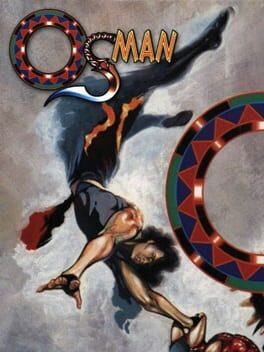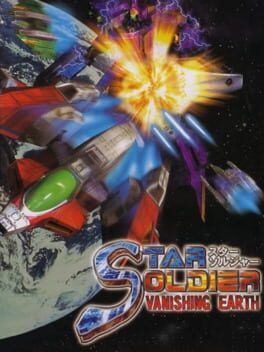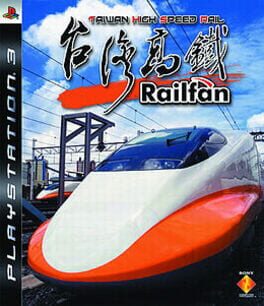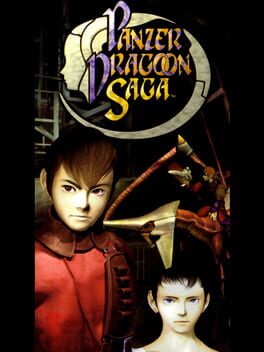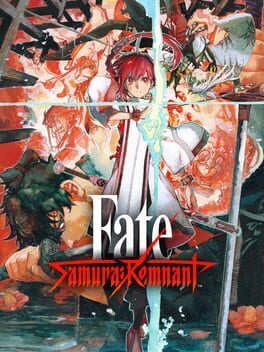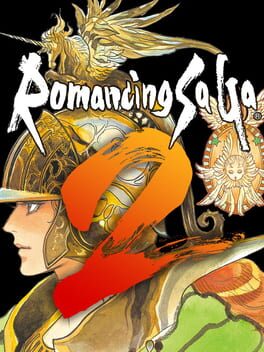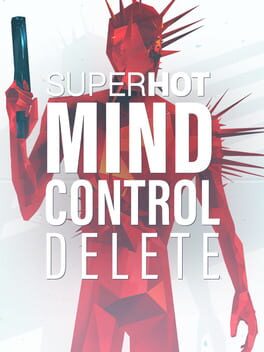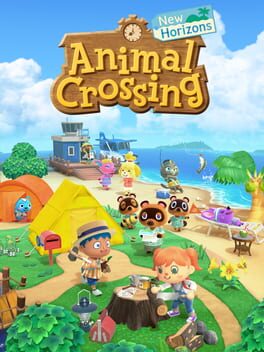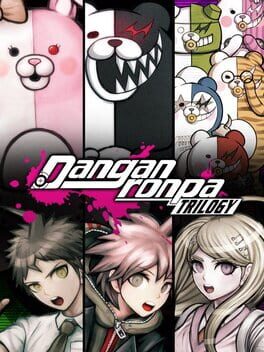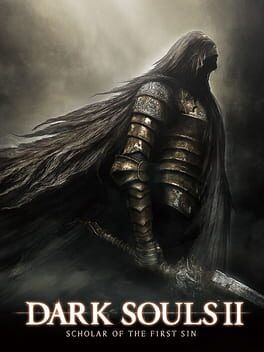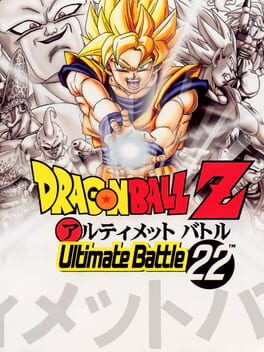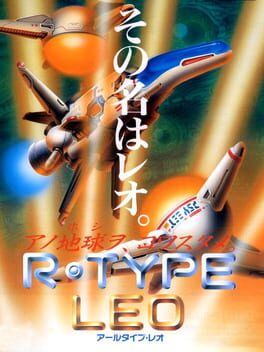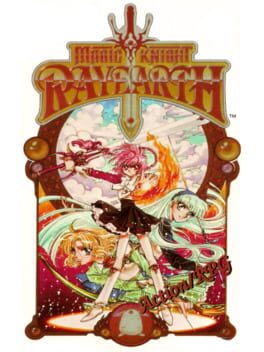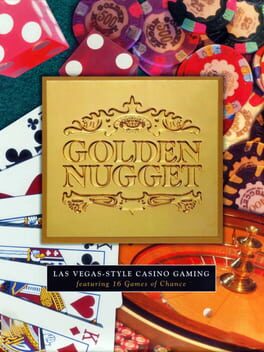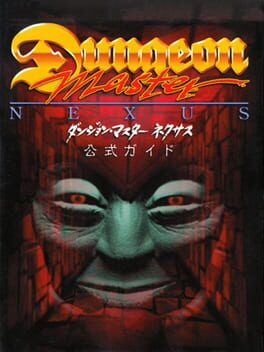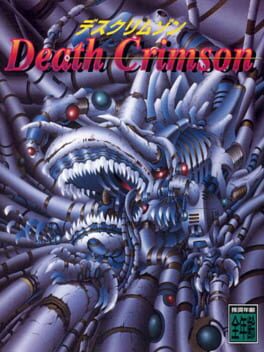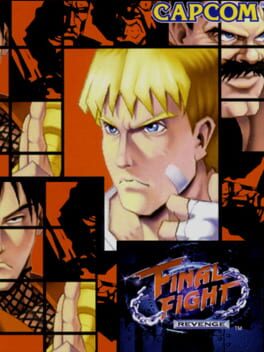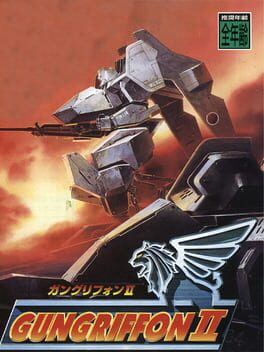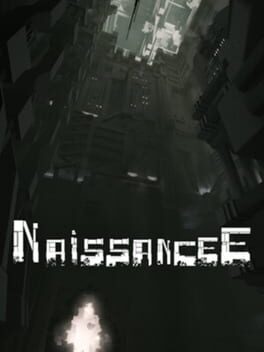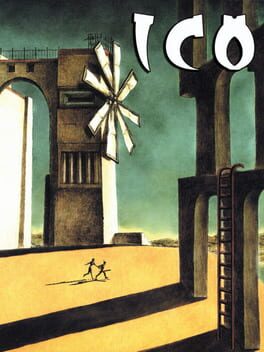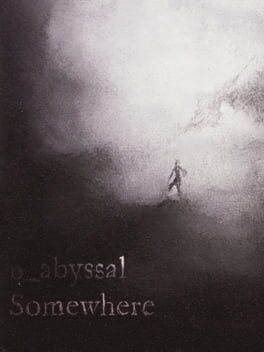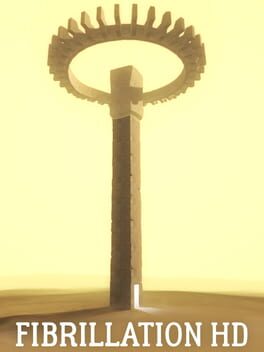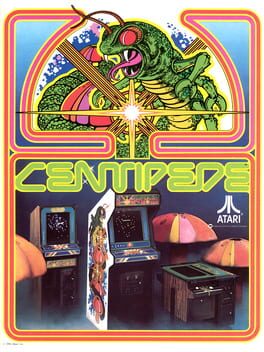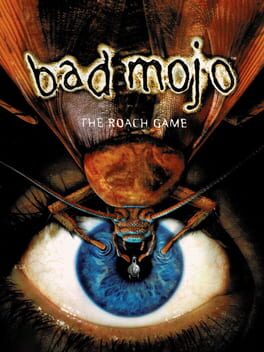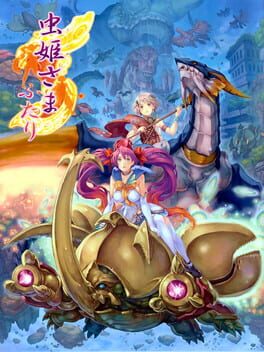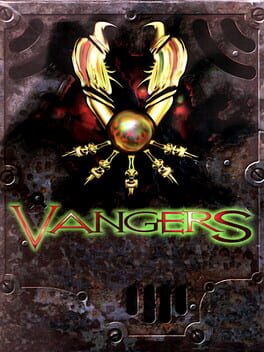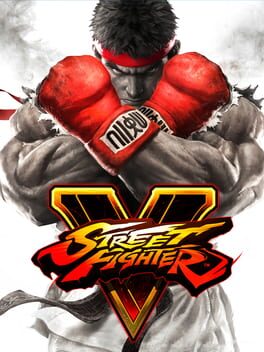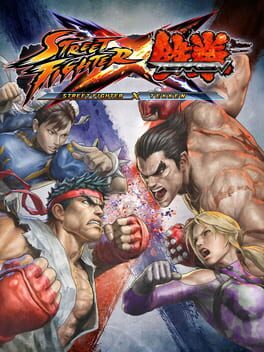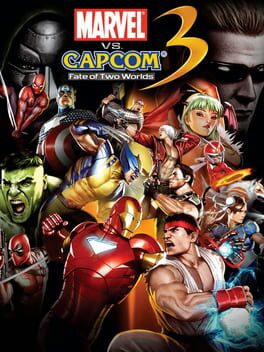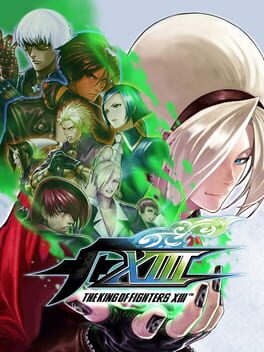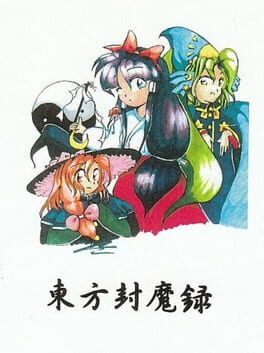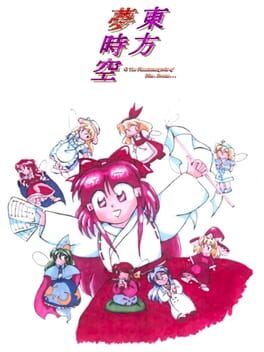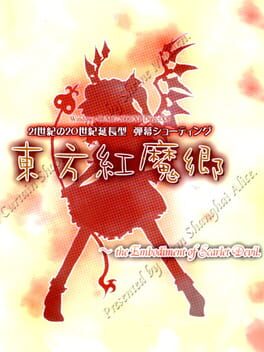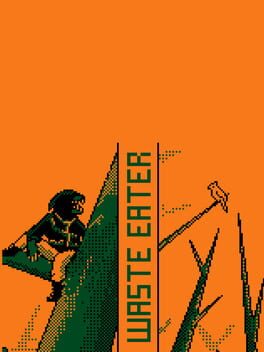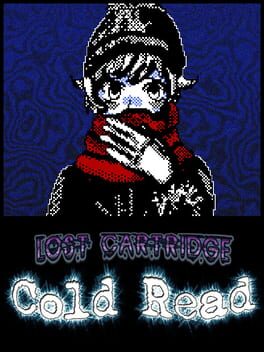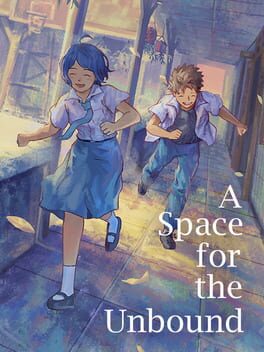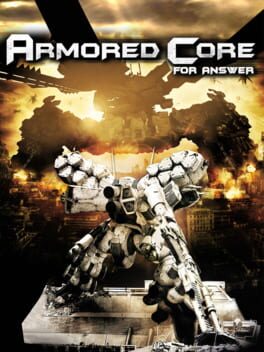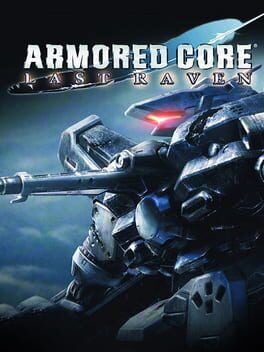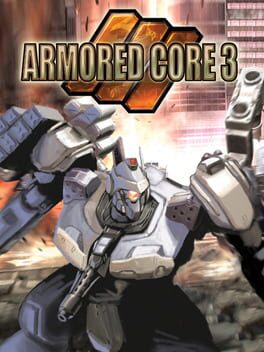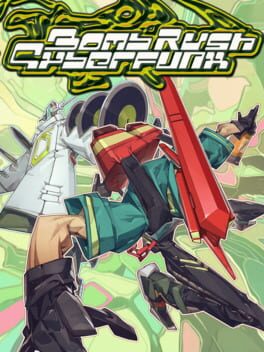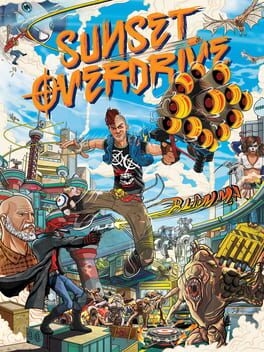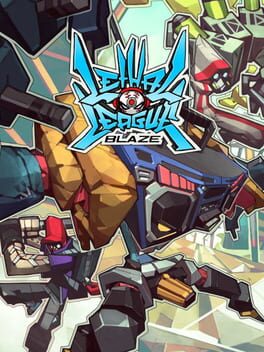romdocitizen
2546 reviews liked by romdocitizen
Emeraldia
1993
I feel a little sorry for Emeraldia. There's potential here, but it doesn't seem like the team really thought about what they were doing. I mean, this is a 1993 Namco puzzle game that they didn't bother porting to the Super Famicom. Can you think of a more damning indictment?
Emeraldia is a fairly typical-looking block-stacking puzzle game, but holy shit is it cute. These are some of the most lovable sprites I've ever seen. Though the gameplay only involves guiding falling blocks around the screen, Adventure Mode insists you're playing as a brave little dolphin called Mint, out to rescue his sea creature friends from the devil of the ocean, Jamir. The game looks really inviting, and the screen's constantly filled with messages from friendly fish, explaining the game to passing observers in the arcade, but it really feels too technical for its own good.
Blocks come down in L-shaped sets of three colours. If you match two colours by dropping them directly on top of each other, they'll both shatter, and later, break. If they're placed in an unbroken horizontal or diagonal line, you can use them for a chain reaction. Having blocks fall down in three parts at a time means you'll need to rely on chain reactions to earn more screen space. It can be a disarmingly tricky game, as each new block with a desirable colour will force another two unwanted colours on you too, and each placement feels like something of a compromise, but I find I do best when I play it like Puyo Puyo or Puzzle Fighter - attempting to assemble groups of colours without breaking them, in the hope they'll cause a big combo later down the line.
Emeraldia is split up into Normal Mode, Adventure Mode and Head-to-Head Play Mode. Despite the names, I think Adventure Mode seems much more like the main mode of the game. In it, you play through pre-made puzzle levels and attempt to free fish, trapped within the blocks. It's the cutest mode, with the most sense of character, and little story boxes every now and then. When you save a fish, there's a little digitised voiceclip that says "Thank you!". It's undoubtedly the mode that new players will want to try when they first come across an Emeraldia cabinet, but Mint's there on the main menu, recommending you start with Normal Mode. This strips out all sense of character that the game has, and just becomes an abstract block-stacking survival puzzle. You play until you fail, and there's no reward other than the potential to place on the high score screen, but it's the most direct way to understand the fundamentals and balance of the game. Then, there's Head-to-Head, which is just a 2-player versus mode with no option to play against a CPU. Despite how relatively small a part of the game Head-to-Head is, it defines the whole of the rest of the game, as you play everything in a little window to the left-hand side of the screen, with the right reserved for Player 2, who plays as a pink dolphin. I imagine a lot of players came to try for the first time, jumped into the two-player, didn't really know what they were doing, and walked away dissatisfied, looking for something that was actually fun.
That's the shame with this. I think there's an interesting puzzle dynamic in here, but it's badly framed. I didn't really know what I was doing until several levels into Adventure Mode, and I only made it that far because I was playing an Arcade Archives release that I'd already paid for, and the continues were free. Even now, I don't feel like a particularly good Emeraldia player. I think a really cute puzzle game ought to have very easily understood rules. Yes, I think they should be something like Puzzle Bobble. Puyo Puyo is a bit borderline, but it still seems a little aged-up from this, and you can make it through a few early levels without understanding the deeper strategies. Emeraldia looks like a game for the world's sweetest babies, but feels crueller than the puzzle game they made under the totalitarian rule of the Soviet Union. I don't think they really structured the game modes very well. There likely ought to be a mode that you play against the computer, as your dolphin reacts with funny animations in the side of the screen. I think the game came together best in Adventure Mode's last level, where we're told Mint is escaping from a crumbling cave with his fellow dolphin hostages. You start with a blank screen, but dolphins descend as part of the blocks, and you need to place them carefully to free them as quickly as possible. Why is that just one level, and not a full mode? Why do I have to play the whole story mode to get to the part with the most compelling gameplay hook?
Emeraldia's aesthetic tells one story, while its gameplay tells another. I don't think they necessarily needed to make this more simple and accessible, either. I could see this gaining an audience of hardened puzzle champions if they drew very dull, dry graphics for it, but then, they probably should have put a little more thought into its modes, too. I have sympathy for the developers. 1993 was a hideously busy time for Namco, and I don't think they really gave a shit about Emeraldia while they were focused on launching Ridge Racer, Cyber Sled and Air Combat. There wasn't any time to revise what they'd already made. It was sent into arcades to die in a dusty corner while visitors lost their minds over their first experiences with 3D. I'm very sorry. I think there's something here, and I really like Mint. I just wish they made his game better.
Emeraldia is a fairly typical-looking block-stacking puzzle game, but holy shit is it cute. These are some of the most lovable sprites I've ever seen. Though the gameplay only involves guiding falling blocks around the screen, Adventure Mode insists you're playing as a brave little dolphin called Mint, out to rescue his sea creature friends from the devil of the ocean, Jamir. The game looks really inviting, and the screen's constantly filled with messages from friendly fish, explaining the game to passing observers in the arcade, but it really feels too technical for its own good.
Blocks come down in L-shaped sets of three colours. If you match two colours by dropping them directly on top of each other, they'll both shatter, and later, break. If they're placed in an unbroken horizontal or diagonal line, you can use them for a chain reaction. Having blocks fall down in three parts at a time means you'll need to rely on chain reactions to earn more screen space. It can be a disarmingly tricky game, as each new block with a desirable colour will force another two unwanted colours on you too, and each placement feels like something of a compromise, but I find I do best when I play it like Puyo Puyo or Puzzle Fighter - attempting to assemble groups of colours without breaking them, in the hope they'll cause a big combo later down the line.
Emeraldia is split up into Normal Mode, Adventure Mode and Head-to-Head Play Mode. Despite the names, I think Adventure Mode seems much more like the main mode of the game. In it, you play through pre-made puzzle levels and attempt to free fish, trapped within the blocks. It's the cutest mode, with the most sense of character, and little story boxes every now and then. When you save a fish, there's a little digitised voiceclip that says "Thank you!". It's undoubtedly the mode that new players will want to try when they first come across an Emeraldia cabinet, but Mint's there on the main menu, recommending you start with Normal Mode. This strips out all sense of character that the game has, and just becomes an abstract block-stacking survival puzzle. You play until you fail, and there's no reward other than the potential to place on the high score screen, but it's the most direct way to understand the fundamentals and balance of the game. Then, there's Head-to-Head, which is just a 2-player versus mode with no option to play against a CPU. Despite how relatively small a part of the game Head-to-Head is, it defines the whole of the rest of the game, as you play everything in a little window to the left-hand side of the screen, with the right reserved for Player 2, who plays as a pink dolphin. I imagine a lot of players came to try for the first time, jumped into the two-player, didn't really know what they were doing, and walked away dissatisfied, looking for something that was actually fun.
That's the shame with this. I think there's an interesting puzzle dynamic in here, but it's badly framed. I didn't really know what I was doing until several levels into Adventure Mode, and I only made it that far because I was playing an Arcade Archives release that I'd already paid for, and the continues were free. Even now, I don't feel like a particularly good Emeraldia player. I think a really cute puzzle game ought to have very easily understood rules. Yes, I think they should be something like Puzzle Bobble. Puyo Puyo is a bit borderline, but it still seems a little aged-up from this, and you can make it through a few early levels without understanding the deeper strategies. Emeraldia looks like a game for the world's sweetest babies, but feels crueller than the puzzle game they made under the totalitarian rule of the Soviet Union. I don't think they really structured the game modes very well. There likely ought to be a mode that you play against the computer, as your dolphin reacts with funny animations in the side of the screen. I think the game came together best in Adventure Mode's last level, where we're told Mint is escaping from a crumbling cave with his fellow dolphin hostages. You start with a blank screen, but dolphins descend as part of the blocks, and you need to place them carefully to free them as quickly as possible. Why is that just one level, and not a full mode? Why do I have to play the whole story mode to get to the part with the most compelling gameplay hook?
Emeraldia's aesthetic tells one story, while its gameplay tells another. I don't think they necessarily needed to make this more simple and accessible, either. I could see this gaining an audience of hardened puzzle champions if they drew very dull, dry graphics for it, but then, they probably should have put a little more thought into its modes, too. I have sympathy for the developers. 1993 was a hideously busy time for Namco, and I don't think they really gave a shit about Emeraldia while they were focused on launching Ridge Racer, Cyber Sled and Air Combat. There wasn't any time to revise what they'd already made. It was sent into arcades to die in a dusty corner while visitors lost their minds over their first experiences with 3D. I'm very sorry. I think there's something here, and I really like Mint. I just wish they made his game better.
A genuinely magical game that’s kept me thinking about it and will continue having this grip on me for quite some time. Games that utilise the medium to such an extent that their identity hinges on the interactive element being present are some of the most fun ones to let sit with you, and this is one of my favourite instances of it. Return of the Obra Dinn is one of the greatest mystery games I’ve played and a lot of this is owed to the structure of the game, forgoing crafting a mystery specifically designed to surprise the player with its various twists and instead laying it all out bare and forcing you to pick everything apart to fully grasp the finer details of things. The mystery and story themselves are not the important aspects here, it’s just trying to immerse you into the role of a detective without any handholding beyond the bare essentials, and it does so perfectly.
Return of the Obra Dinn is a mystery/puzzle game that revolves around incomplete information and assumption, often leaving little to no definitive evidence and forcing you to jump all around to place with increasingly tenuous lines of logic as you feel yourself going insane. It was quite funny taking a step back after combing through a few scenes in excruciating detail and just thinking “wow, this is deranged” but that’s just how the game is. The player is likely to find all of the story beats of the game rather early on without knowing the fates of the vast majority of the cast, and then the rest of the game boils down to going between the relevant scenes in the game to try and figure out how to deduce some of them, which would seem like an experience that would feel stagnant very quickly, but is saved due to the sense of progression that will take place despite it all just looking like cleanup at first. The progression gates in this game are entirely dependent on and driven by the player, hinging on multiple big realisations on how they need to approach their investigations. This culminates in a deeply rewarding loop of thinking that you’ve hit the logical endpoint of what you achieve on your own, before realising a new detail that leads you down a new line of logic to discover someone, and then applying this newfound understanding of how to figure something out to other characters. A contributing factor to how this is so successful is due to the plethora of approaches that you’re expected to work out, sometimes really being as simple but uncertain feeling as “this guy hangs around this other guy a lot, they’re probably in the same field”.
The way that your answers are confirmed is a clever way of limiting the ability to brute force a lot of puzzle answers as well, since you’ve only got confirmation on whether you’re correct or not once you have 3 correct answers simultaneously written down. While some amount of guesswork was an expected element of this game’s design, by structuring it like this, players are still forced to confidently deduce 2 other people before they can start taking real shots in the dark with incomplete assumptions, solving a problem I’ve seen time and time again in deduction games where people will often resort to total guesswork the moment they’re met with some confusion and uncertainty. The presentation goes a long way in tying everything together as well, being visually striking while having the effect of being simple enough to make the important details easier to pinpoint while simultaneously obscuring everything just enough to invite uncertainty into every observation. I adore whenever a game can keep me thinking for so long after I’m done with it, and I love it even more when it does so through something as esoteric as it is here. Total masterpiece, something new to add to my list of favourites.
Return of the Obra Dinn is a mystery/puzzle game that revolves around incomplete information and assumption, often leaving little to no definitive evidence and forcing you to jump all around to place with increasingly tenuous lines of logic as you feel yourself going insane. It was quite funny taking a step back after combing through a few scenes in excruciating detail and just thinking “wow, this is deranged” but that’s just how the game is. The player is likely to find all of the story beats of the game rather early on without knowing the fates of the vast majority of the cast, and then the rest of the game boils down to going between the relevant scenes in the game to try and figure out how to deduce some of them, which would seem like an experience that would feel stagnant very quickly, but is saved due to the sense of progression that will take place despite it all just looking like cleanup at first. The progression gates in this game are entirely dependent on and driven by the player, hinging on multiple big realisations on how they need to approach their investigations. This culminates in a deeply rewarding loop of thinking that you’ve hit the logical endpoint of what you achieve on your own, before realising a new detail that leads you down a new line of logic to discover someone, and then applying this newfound understanding of how to figure something out to other characters. A contributing factor to how this is so successful is due to the plethora of approaches that you’re expected to work out, sometimes really being as simple but uncertain feeling as “this guy hangs around this other guy a lot, they’re probably in the same field”.
The way that your answers are confirmed is a clever way of limiting the ability to brute force a lot of puzzle answers as well, since you’ve only got confirmation on whether you’re correct or not once you have 3 correct answers simultaneously written down. While some amount of guesswork was an expected element of this game’s design, by structuring it like this, players are still forced to confidently deduce 2 other people before they can start taking real shots in the dark with incomplete assumptions, solving a problem I’ve seen time and time again in deduction games where people will often resort to total guesswork the moment they’re met with some confusion and uncertainty. The presentation goes a long way in tying everything together as well, being visually striking while having the effect of being simple enough to make the important details easier to pinpoint while simultaneously obscuring everything just enough to invite uncertainty into every observation. I adore whenever a game can keep me thinking for so long after I’m done with it, and I love it even more when it does so through something as esoteric as it is here. Total masterpiece, something new to add to my list of favourites.
Osman
1996
Creating afterimages to pummel giant Persian-influenced gods and mechanoloids is something truly special, though the inclusion of checkpoints at a few select stages puts this in a weird spot where you CAN credit-feed it but you'll be burning about 30-45 minutes routing out one specific boss rematch section, very bizarre
Dude why did I give this a 1.5 before
This game leaves a weird first impression, has kind of that Thunder Force effect where enemies don't attack much but when they do it has almost no pre-empt and an unforgiving hitbox. Then you get to the bosses and their bullet patterns seem impossible to avoid. But on replaying this I learned 2 crucial things:
1) You have a dodgeroll that reflects everything and can be used anytime
2) This game has DDP chaining and you get OBSCENE amounts of extends
Combining these two makes for a very unconventional shmup, because you're not so much dodging as you are managing the dodgeroll economy and trying to keep a constant stream of damage on-screen. It's an extremely modernist and indie conceit but handled very well because of the freckles of shmup fundamentals underneath and stellar cyberspace resonance.
Clearly, between this, Sin & Punishment, Star Fox 64 and that cancelled Viewpoint sequel, the N64 needed waaaaaay more shmuppin' in its veins.
This game leaves a weird first impression, has kind of that Thunder Force effect where enemies don't attack much but when they do it has almost no pre-empt and an unforgiving hitbox. Then you get to the bosses and their bullet patterns seem impossible to avoid. But on replaying this I learned 2 crucial things:
1) You have a dodgeroll that reflects everything and can be used anytime
2) This game has DDP chaining and you get OBSCENE amounts of extends
Combining these two makes for a very unconventional shmup, because you're not so much dodging as you are managing the dodgeroll economy and trying to keep a constant stream of damage on-screen. It's an extremely modernist and indie conceit but handled very well because of the freckles of shmup fundamentals underneath and stellar cyberspace resonance.
Clearly, between this, Sin & Punishment, Star Fox 64 and that cancelled Viewpoint sequel, the N64 needed waaaaaay more shmuppin' in its veins.
Taipei ➡️ Zuoying (Kaohsiung City)
Duration: 01h34
Train Model: THSR 700T
Train No: 0145
Number of carriages: 12 (1 business car, 11 standard cars)
Number of seats: 989 (66 seats in business car, 923 seats in standard cars)
Seat allocation: 2+2 in business car (4 seats each row); 2+3 in standard car (5 seats each row)
Top operation speed: 300 km/hr
Length of train: 304 m
Electric system: 25 KV 60 Hz AC
Welcome aboard Taiwan High Speed Rail! This train is bound from Taipei, to Zuoying. All seats are reserved. Please make sure you are in the correct seat. We wish you a pleasant journey. 🌸
Slim but unquestionably reverent and adorable. Maybe I'm gassing this up too much but it's nice to see the Trainguy subgenre have a little more meat on its bones beyond polygonal simulations and instead could be secret FMV games - accelerating and decelerating your train like it's a really meditative Superhot or something. Railfan seems very keen to show you a brief look into late-00's rail transit life, right down to explaining the historicity of the locales the line calls at, the specs of the train, even local cuisine!
Looking up the devs of the Railfan titles to find that they are predominantly dedicated to educative tactile train driving simulations, still making use of full-motion video rather than computer generated sims. I dunno man I think that's neat. I've seen people with the Densha de Go joystick but now I want a carriage door peripheral for me to lean out of.
Duration: 01h34
Train Model: THSR 700T
Train No: 0145
Number of carriages: 12 (1 business car, 11 standard cars)
Number of seats: 989 (66 seats in business car, 923 seats in standard cars)
Seat allocation: 2+2 in business car (4 seats each row); 2+3 in standard car (5 seats each row)
Top operation speed: 300 km/hr
Length of train: 304 m
Electric system: 25 KV 60 Hz AC
Welcome aboard Taiwan High Speed Rail! This train is bound from Taipei, to Zuoying. All seats are reserved. Please make sure you are in the correct seat. We wish you a pleasant journey. 🌸
Slim but unquestionably reverent and adorable. Maybe I'm gassing this up too much but it's nice to see the Trainguy subgenre have a little more meat on its bones beyond polygonal simulations and instead could be secret FMV games - accelerating and decelerating your train like it's a really meditative Superhot or something. Railfan seems very keen to show you a brief look into late-00's rail transit life, right down to explaining the historicity of the locales the line calls at, the specs of the train, even local cuisine!
Looking up the devs of the Railfan titles to find that they are predominantly dedicated to educative tactile train driving simulations, still making use of full-motion video rather than computer generated sims. I dunno man I think that's neat. I've seen people with the Densha de Go joystick but now I want a carriage door peripheral for me to lean out of.
You may notice that Metroid Prime is listed in my top 5. In retrospect, I only beat it once, around 2005. It felt enormous, long, lonely, personal. It felt like an experience I couldn't really relive. The way you play the first time is simply not the way you'd play it again. I kept trying to find games that recaptured the way it felt — I think maybe Halo 3: ODST came close. It still wasn't quite Metroid Prime.
The thing that makes Metroid Prime downright unique among the rest of the trilogy is that you have no companions. You are absolutely alone. You wander around and can only find a very old world, R&D diaries, endless dead with suggestive injuries, and a gentle unease as you come to realise how little time is actually left for the world you've come across.
There is no moral propulsion to your journey. It's not done as a favour to anyone nor are you beholden to anyone but yourself in what you're doing. Metroid Prime is just solitary, patient exploration; there are so many tiny trials just a little bit off the core path where you can come and earn a little bit more power. It's a great playbook; Breath of the Wild did it well a decade and a half later.
Remastered in turn is an absolute masterwork. It's basically exactly what I would want from a rerelease of the game; it considers everything from narration to control scheme with a nice selection and the new look and feel is very faithful. It matches memories while feeling current, as if Prime simply always looked like this. Animations, map layout, game structure, are all identical. It's the same game, just incredibly beautiful.
That said I do wonder about some of the annoyances of the original game being preserved as-is; would it have been better without the endless Chozo ghosts? Would the Phazon Mines be a touch nicer with even just one bonus save room on the second or third floor, so it isn't an hour-long gauntlet to the Power Bomb? Is it better to just leave it be? I guess they decided yes, and I guess any deviance at all would've opened the door for more...
The thing that makes Metroid Prime downright unique among the rest of the trilogy is that you have no companions. You are absolutely alone. You wander around and can only find a very old world, R&D diaries, endless dead with suggestive injuries, and a gentle unease as you come to realise how little time is actually left for the world you've come across.
There is no moral propulsion to your journey. It's not done as a favour to anyone nor are you beholden to anyone but yourself in what you're doing. Metroid Prime is just solitary, patient exploration; there are so many tiny trials just a little bit off the core path where you can come and earn a little bit more power. It's a great playbook; Breath of the Wild did it well a decade and a half later.
Remastered in turn is an absolute masterwork. It's basically exactly what I would want from a rerelease of the game; it considers everything from narration to control scheme with a nice selection and the new look and feel is very faithful. It matches memories while feeling current, as if Prime simply always looked like this. Animations, map layout, game structure, are all identical. It's the same game, just incredibly beautiful.
That said I do wonder about some of the annoyances of the original game being preserved as-is; would it have been better without the endless Chozo ghosts? Would the Phazon Mines be a touch nicer with even just one bonus save room on the second or third floor, so it isn't an hour-long gauntlet to the Power Bomb? Is it better to just leave it be? I guess they decided yes, and I guess any deviance at all would've opened the door for more...
Panzer Dragoon Saga
1998
This review contains spoilers
Something curious happens at the very start of this game. The hero straight up dies, and then the game simply asks, "The one who controls Edge - what is your name?"
It wasn't ambiguous — I'm not naming my character. Who am I, personally?
The power of my name alone brought the man back to life.
The concept of the Divine Visitor in this game is not an off-the-cuff fourth wall integration. It completely changes our relationship to the game world. We are not partaking in a fantasy that someone else perpetuates; instead, we are the impossible being. Only something outside this world could possibly save it.
I kept thinking about this concept as I played; and honestly, a lot about this game really frustrated me. Traversing the towns is a bit tedious, the plot gates are really obtuse and sometimes a specific conversation flag is tripped by talking to all people at all times of day or by asking someone something 25 times without any indication that the next time you ask them, they'll say something new. Sometimes conversations are hinged on what you've overheard from someone else, meaning you have to from town to town keep in mind what to eavesdrop and what to share directly.
They're novel ideas; and they don't always work. The thing about experimentation is that it means half your systems are going to be obstacles for the player to overcome.
On the other hand, I really enjoyed the battle system. It perfected the risk/reward balance and was generally navigable without being too frustrating. Random encounters really made me not want to explore too aggressively, but when it came to boss rushes, I didn't feel overburdened by the challenge.
Around disc 3 I started to really catch the tone of this game. It feels overwhelmingly doomed, bleak, sad. It's just endless death and war. I do not know the lore. But I know the reality of the situation: all these people were living their lives while God's meat puppet and a biotechnological droid were the only things in the way of world-historical systems spanning millennia that only existed to cull and control. Everyone is absolutely powerless in the face of a machine designed by someone else.
These impossible beings appear from nowhere, develop inevitable fondness, then disperse. Edge evaporates after seeing the face of God for one moment, and our mutual loan concludes. Azel wanders the rest of her life seeking someone who should've never existed long enough to see her.
Miracles conclude. The world goes on. There are simply fewer people seeking to master power and violence. That's the best our sacred magic can do.
It wasn't ambiguous — I'm not naming my character. Who am I, personally?
The power of my name alone brought the man back to life.
The concept of the Divine Visitor in this game is not an off-the-cuff fourth wall integration. It completely changes our relationship to the game world. We are not partaking in a fantasy that someone else perpetuates; instead, we are the impossible being. Only something outside this world could possibly save it.
I kept thinking about this concept as I played; and honestly, a lot about this game really frustrated me. Traversing the towns is a bit tedious, the plot gates are really obtuse and sometimes a specific conversation flag is tripped by talking to all people at all times of day or by asking someone something 25 times without any indication that the next time you ask them, they'll say something new. Sometimes conversations are hinged on what you've overheard from someone else, meaning you have to from town to town keep in mind what to eavesdrop and what to share directly.
They're novel ideas; and they don't always work. The thing about experimentation is that it means half your systems are going to be obstacles for the player to overcome.
On the other hand, I really enjoyed the battle system. It perfected the risk/reward balance and was generally navigable without being too frustrating. Random encounters really made me not want to explore too aggressively, but when it came to boss rushes, I didn't feel overburdened by the challenge.
Around disc 3 I started to really catch the tone of this game. It feels overwhelmingly doomed, bleak, sad. It's just endless death and war. I do not know the lore. But I know the reality of the situation: all these people were living their lives while God's meat puppet and a biotechnological droid were the only things in the way of world-historical systems spanning millennia that only existed to cull and control. Everyone is absolutely powerless in the face of a machine designed by someone else.
These impossible beings appear from nowhere, develop inevitable fondness, then disperse. Edge evaporates after seeing the face of God for one moment, and our mutual loan concludes. Azel wanders the rest of her life seeking someone who should've never existed long enough to see her.
Miracles conclude. The world goes on. There are simply fewer people seeking to master power and violence. That's the best our sacred magic can do.
Fate/Samurai Remnant
2023
This was initially on my backlog as "hell yea more Fate trash" because I can't help but be soothed by it. But then I stepped it up earlier in the backlog because people were saying it has a surprisingly good story!
And I agree, I think that for the kind of game it is, the story is really competently done. It's just done in the same way Fate/Apocrypha is -- and of course, the two share a scenario writer -- where the mechanics of the narrative framework are explored in a really interesting way, but the emotional beats are hit just for the sake of hitting emotional beats. Fate has a bit of a late Star Wars problem where as we actually define the mechanics -- "Saint Graphs" and "Spirit Origins" and so forth -- our characters themselves become aware of these concepts, and define themselves more mechanically. None of these words were in the Bible (i.e. Fate/stay night). At the time, they were handwaved concepts and gradually were made law based on the needs of the narrative for the emotional impact.
And like Fate/Apocrypha it sacrifices the emotional climax in favour of a more action-oriented approach. It is indeed quite Cool to watch, and our choice of Servants in this story are also well-picked. So why did I not really get all that into them as people? It kind of had a "damn...that sucks" feel whereas every moment in Fate/stay night ripped right through me. The setup for what these people were feeling was done in excruciating detail. We don't really have room for that in action games nor in 24-episode action anime.
All that said, the game starts out so strong. I think I spent the first 14 hours of this game in two long, long sessions of play. It's just that the loop is not deep enough to carry through the back half. There's mechanics, but they function more as ways of breaking up what is effectively button mashing. As you learn the later stances, you get a lot more from just hitting the X button than you do anything else. It's just walk in a room, see some spawns, hit X, go home. The bosses have some interesting opportunities for Ripostes, and one or two boss fights had me hitting reset and going in for another round (I tried facing Rogue Berserker kinda early).
Omega Force is in a great stride at exactly this: button masher tie-ins to narratively-strong IPs that deliver a great additional narrative within a real basic game loop.
But really I don't know what I'm complaining about. I had a great time! I think I just started out like "holy shit" and I felt sad that I was getting tired of it by the end. I didn't even want to NG+ to do the other story routes.
And I agree, I think that for the kind of game it is, the story is really competently done. It's just done in the same way Fate/Apocrypha is -- and of course, the two share a scenario writer -- where the mechanics of the narrative framework are explored in a really interesting way, but the emotional beats are hit just for the sake of hitting emotional beats. Fate has a bit of a late Star Wars problem where as we actually define the mechanics -- "Saint Graphs" and "Spirit Origins" and so forth -- our characters themselves become aware of these concepts, and define themselves more mechanically. None of these words were in the Bible (i.e. Fate/stay night). At the time, they were handwaved concepts and gradually were made law based on the needs of the narrative for the emotional impact.
And like Fate/Apocrypha it sacrifices the emotional climax in favour of a more action-oriented approach. It is indeed quite Cool to watch, and our choice of Servants in this story are also well-picked. So why did I not really get all that into them as people? It kind of had a "damn...that sucks" feel whereas every moment in Fate/stay night ripped right through me. The setup for what these people were feeling was done in excruciating detail. We don't really have room for that in action games nor in 24-episode action anime.
All that said, the game starts out so strong. I think I spent the first 14 hours of this game in two long, long sessions of play. It's just that the loop is not deep enough to carry through the back half. There's mechanics, but they function more as ways of breaking up what is effectively button mashing. As you learn the later stances, you get a lot more from just hitting the X button than you do anything else. It's just walk in a room, see some spawns, hit X, go home. The bosses have some interesting opportunities for Ripostes, and one or two boss fights had me hitting reset and going in for another round (I tried facing Rogue Berserker kinda early).
Omega Force is in a great stride at exactly this: button masher tie-ins to narratively-strong IPs that deliver a great additional narrative within a real basic game loop.
But really I don't know what I'm complaining about. I had a great time! I think I just started out like "holy shit" and I felt sad that I was getting tired of it by the end. I didn't even want to NG+ to do the other story routes.
Romancing SaGa 2
1993
maybe not the strongest game ever writing or story wise but conceptually and in execution for a jrpg from 1993 romancing saga 2 is incredibly interesting and a game i'll probably be thinking about for a long time. the only version available in english being an inferior remaster definitely doesn't do it any favors for a wider audience, but it's still something worth checking out if you care at all about the genre. my only hope from something like team asano or just the influx of more classic-inspired jrpgs in general is that we go back to an era where we get experimental titles like this again
SUPERHOT.
What matters is what happens between these two words.
SUPERHOT.
It wants to peel back the layers of your skull.
SUPERHOT.
Feast on my flesh until nothing remains.
.
3 thoughts on SUPER[SUPER]HOT.
Mind - Katana reveals all; the swift executions and parry-play are at the essence of what works within this new framework of roguelike repetition because it prevents the action from jerking-off in bullet-time. The staccato begins to act in service of rhythmic motions where physicality is no longer a disembodied affair of firearms and trajectories locating the feedback loop in the anonymity of manikins instead putting our ever-fragile avatar at the center of the violence in ways that renders frisson by putting emphasis on the cut. Distances and deflections. How to bridge the gap between the two. Invoking. Channeling. SUPERHOT.
Control - Hacks.exe; they elevate the core systems without rendering the whole ugly. It’s impossible to escape the allure of the metagame. “Killheal.hack” and “Lightreflex.hack” are kings. And kings do not matter in sequences whose escalating difficulty so clearly correlates with the aesthetics of kinesthesia - strategies are established in style before substance, a perfect action-run framed in replays, so challenge is (and must remain) a modular canvas here. Strong back-half. Exhausting waves met with zen. Repress the urge to shatter - obsidian is thy weapon. Sliced rubies and broken ores. A mist of forms. I wish the experience went further. I wish I didn’t have so many choices. I wish I could look somewhere else than myself by being tied to the grazing of bullets and the compression of space. At its purest SUPERHOT triggers like a reversion of time itself; me, knowing the momentum of damage and enemies so completely that I can speedrun the game. Play it, actually, at a regular pace. Ain’t that something. A slow game, but present.
Delete - Self-vore; masturbartory reflexivity bores me. But SUPERHOT was so close. Its gradual subtraction of every expansions made to the original concept pushes past the cringe by committing to a proper state of powerlessness. But at the end of each stage, when vision itself has been euthanized and verbs stripped away from the player, we’re given the option to give up. Press [E] to access the text. The game should have left us to rot in there. Let the player figure out new ways to still assert dominance over its environment in the absence of tools to do so. The game’s not inventive enough - in both mechanics and level-design - to do that. A shame. All that’s left, then, is a language only dispensed by the screen - our usual one-way mirrors. Ten minutes of me pressing [E] to get the syllables drooling out of my mouth. Sweet nothingness lost in Amygdalatropolis. Yelling that same sentence into the void.
SUPER
HOT
SUPER
HOT
SUPER
HOT
SUPER
HOT
SUPER
HOT
SUPER
HOT
SUPER
[Just a hollow sense of progression and power]
HOT.
What matters is what happens between these two words.
SUPERHOT.
It wants to peel back the layers of your skull.
SUPERHOT.
Feast on my flesh until nothing remains.
.
3 thoughts on SUPER[SUPER]HOT.
Mind - Katana reveals all; the swift executions and parry-play are at the essence of what works within this new framework of roguelike repetition because it prevents the action from jerking-off in bullet-time. The staccato begins to act in service of rhythmic motions where physicality is no longer a disembodied affair of firearms and trajectories locating the feedback loop in the anonymity of manikins instead putting our ever-fragile avatar at the center of the violence in ways that renders frisson by putting emphasis on the cut. Distances and deflections. How to bridge the gap between the two. Invoking. Channeling. SUPERHOT.
Control - Hacks.exe; they elevate the core systems without rendering the whole ugly. It’s impossible to escape the allure of the metagame. “Killheal.hack” and “Lightreflex.hack” are kings. And kings do not matter in sequences whose escalating difficulty so clearly correlates with the aesthetics of kinesthesia - strategies are established in style before substance, a perfect action-run framed in replays, so challenge is (and must remain) a modular canvas here. Strong back-half. Exhausting waves met with zen. Repress the urge to shatter - obsidian is thy weapon. Sliced rubies and broken ores. A mist of forms. I wish the experience went further. I wish I didn’t have so many choices. I wish I could look somewhere else than myself by being tied to the grazing of bullets and the compression of space. At its purest SUPERHOT triggers like a reversion of time itself; me, knowing the momentum of damage and enemies so completely that I can speedrun the game. Play it, actually, at a regular pace. Ain’t that something. A slow game, but present.
Delete - Self-vore; masturbartory reflexivity bores me. But SUPERHOT was so close. Its gradual subtraction of every expansions made to the original concept pushes past the cringe by committing to a proper state of powerlessness. But at the end of each stage, when vision itself has been euthanized and verbs stripped away from the player, we’re given the option to give up. Press [E] to access the text. The game should have left us to rot in there. Let the player figure out new ways to still assert dominance over its environment in the absence of tools to do so. The game’s not inventive enough - in both mechanics and level-design - to do that. A shame. All that’s left, then, is a language only dispensed by the screen - our usual one-way mirrors. Ten minutes of me pressing [E] to get the syllables drooling out of my mouth. Sweet nothingness lost in Amygdalatropolis. Yelling that same sentence into the void.
SUPER
HOT
SUPER
HOT
SUPER
HOT
SUPER
HOT
SUPER
HOT
SUPER
HOT
SUPER
[Just a hollow sense of progression and power]
HOT.
184 lists liked by romdocitizen
by fascinator |
31 Games
by Vee |
24 Games
by annelidist |
17 Games
by Dreamboat |
18 Games
by TransWitchSammy |
80 Games
by LunaEndlessWitch |
111 Games
by CycloneJoker |
14 Games
by FallenGrace |
15 Games


